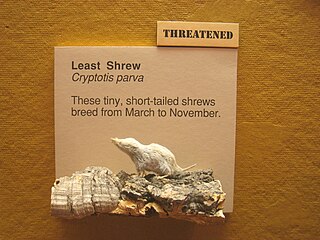
The genus Cryptotis is a group of relatively small shrews with short ears, which are usually not visible, and short tails, commonly called small-eared shrews. They have 30 teeth and are members of the red-toothed shrew subfamily. Since 1992, Neal Woodman at the United States National Museum has been in the process of revising the genus. To date, this has resulted in an increase in the number of species from 12 to 30.

Enders's small-eared shrew is a species of mammal in the family Soricidae. It is endemic to Panama.

Goldman's broad-clawed shrew is a species of mammal in the family Soricidae. It is found in Guatemala and Mexico.

Goodwin's broad-clawed shrew is a species of mammal in the shrew family, Soricidae. Body length and size of adults average 9.49 cm and 7.0 grams respectively making it a relatively larger shew. What distinguishes this from other shrews are its long claws.

The Honduran small-eared shrew is a species of mammal in the family Soricidae. It is found in Honduras and possibly in El Salvador, Guatemala, and Nicaragua.
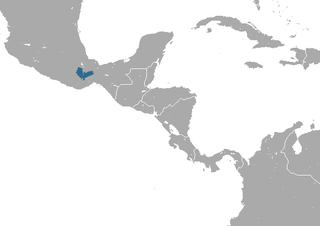
The big Mexican small-eared shrew is a species of mammal in the family Soricidae. It is endemic to Mexico.

The Mexican small-eared shrew is a species of mammal in the family Soricidae. It is endemic to Mexico.

The wandering small-eared shrew is a species of shrew in the family Soricidae. It is endemic to Ecuador.

The scaly-footed small-eared shrew is a species of mammal in the family Soricidae. It is found in Colombia and Ecuador.

Thomas's small-eared shrew is a species of mammal in the family Soricidae. It is found in Colombia, Ecuador, and Peru.
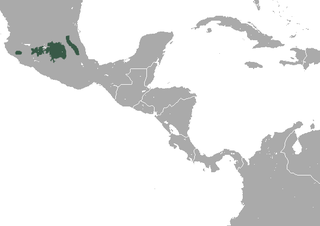
The Central Mexican broad-clawed shrew is a species of mammal in the family Soricidae. It is found in the highlands above 2000 m in the Mexican states of Colima, Hidalgo, Jalisco, Michoacán, Mexico, and Puebla, Morelos, and in the Mexican Federal District
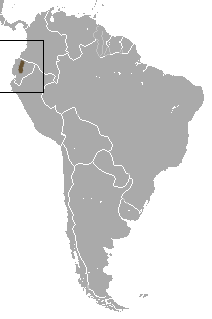
The Ecuadorian small-eared shrew is a species of shrew in the family Soricidae. It is found on the western and eastern slopes of the Andes in central Ecuador.

The tropical small-eared shrew is a very small mammal of the family Soricidae. The species is found in the eastern highlands of Chiapas, Mexico, and parts of Belize and Guatemala. Until recently, it was considered a subspecies of the North American least shrew, but it has gained species status. Its relationship with the Central American least shrew remains to be studied.
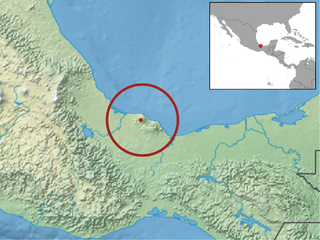
Nelson's small-eared shrew is a species of mammal in the family Soricidae. It is endemic to eastern Mexico.

The Colombian small-eared shrew is a species of mammal in the family Soricidae. It is endemic to Colombia, where it is known from the Cordillera Central in Antioquia Department at elevations from 1,750 to 2,800 m. It is found in montane forest and cultivated areas. It resembles C. brachyonyx.
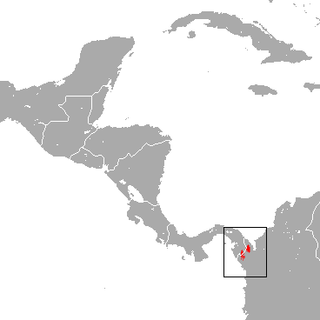
The Darién small-eared shrew is a species of mammal in the family Soricidae. It is known only from montane regions along the border between Colombia and Darién Province, Panama, where it has been found in rainforest at elevations from 1400 to 1500 m. It has terrestrial habits.
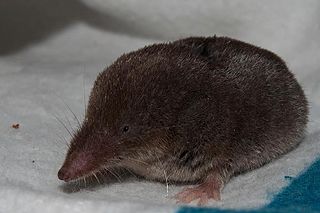
The Central American least shrew is a species of mammal in the family Soricidae. It is found in the highlands and mid-elevations from the western part of the northern coast of Honduras to central Costa Rica. It is found in El Salvador, Honduras, Nicaragua, and Costa Rica. It was considered to be a subspecies of the North American least shrew until 2002.
The grizzled Mexican small-eared shrew is a small mammal in the order Eulipotyphla. It is native to the Sierra Madre Oriental of eastern Mexico. It can be found in dense, wet cloud forest, where it is found in the thick herbaceous undergrowth and leaf litter. It is known to be insectivorous and terrestrial. Threats to the species are deforestation for agriculture and urban development.
The Oaxacan broad-clawed shrew is a species of mammal in the family Soricidae. It is found in Oaxaca in Mexico.
Phillips' small-eared shrew or Phillips' short-eared shrew is a species of mammal in the family Soricidae found in Mexico.


















